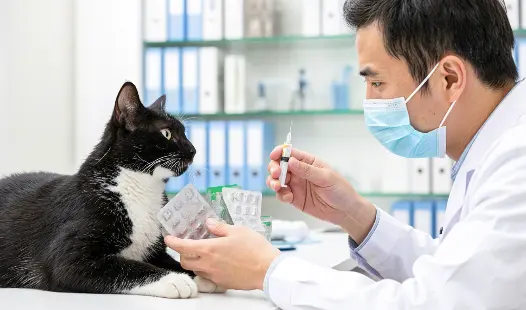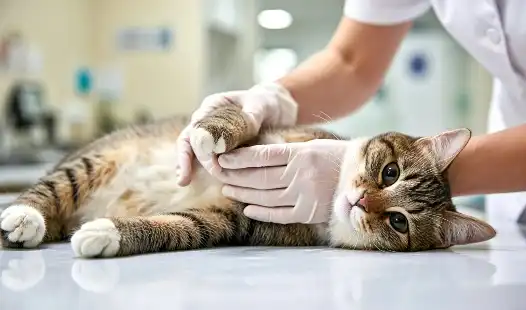While behavioral changes can be subtle, FIP symptoms and other physical signs of the disease can be more apparent. However, some FIP symptoms may still be easy to miss without careful observation, making regular monitoring and prompt veterinary attention essential for early detection and effective management.
How to Recognize FIP Symptoms Early?
Subtle Behavioral Changes to Watch For
One of the most dangerous viral diseases that cats may have is Feline Infectious Peritonitis (FIP). Timely management and a better prognosis may be achieved with early recognition of GS-441524 FIP symptoms. By reading this detailed information, both cat owners and veterinarians will be better able to recognise the subtle symptoms of feline infectious peritonitis (FIP) and intervene quickly when needed.
|
|
|
Subtle Behavioral Changes to Watch For
FIP can manifest in various ways, often beginning with subtle behavioral shifts that may be easily overlooked. Being attuned to these changes can make a significant difference in early detection.
Lethargy and Decreased Activity
One of the first signs of FIP may be a noticeable decrease in your cat's energy levels. Cats affected by FIP often exhibit:
- Reduced playfulness
- Increased sleeping
- Reluctance to engage in usual activities
Changes in Appetite and Water Intake
Alterations in eating and drinking habits can be indicative of FIP. Look out for:
- Loss of appetite
- Increased thirst
- Difficulty eating or drinking
Social Behavior Alterations
Cats with FIP may display changes in their social interactions:
- Withdrawal from family members
- Unusual aggression or irritability
- Seeking more attention or comfort than usual
Physical Signs: Beyond the Obvious
Ocular and Neurological Symptoms
FIP can affect a cat's eyes and nervous system, leading to:
- Changes in eye color or pupil size
- Cloudiness in the eyes
- Abnormal eye movements
- Impaired coordination or balance
Respiratory Issues
Respiratory symptoms can be indicative of FIP, particularly in its wet form:
- Labored breathing
- Rapid breathing (tachypnea)
- Nasal discharge
Gastrointestinal Disturbances
FIP can cause various gastrointestinal issues, including:
- Diarrhea
- Vomiting
- Abdominal distension (pot-bellied appearance)
Skin and Coat Changes
Pay attention to alterations in your cat's skin and coat:
- Jaundice (yellowing of the skin and mucous membranes)
- Poor coat condition
- Skin lesions or ulcers
|
|
|
|
When to Seek Immediate Veterinary Care?
While early detection is crucial, certain FIP symptoms warrant immediate veterinary attention. Understanding these critical FIP symptoms can help ensure prompt medical intervention and improve the chances of effective treatment and recovery for affected cats.
Severe Lethargy or Collapse
If your cat displays extreme weakness, refusal to move, or collapses suddenly, it should be treated as a medical emergency. Such symptoms may suggest that the disease has reached an advanced stage, causing severe inflammation and systemic distress. Cats with FIP often experience progressive fatigue as their body struggles to combat the infection. Immediate veterinary attention is necessary to stabilize your cat, identify the underlying cause, and begin supportive care to prevent further deterioration.
Persistent Fever
A persistent or recurring fever that does not respond to antibiotics is one of the most distinctive indicators of FIP. This type of fever often fluctuates throughout the day but remains above the normal range for cats. Continuous fever suggests the immune system is engaged in a prolonged and ineffective battle against the virus. Pet owners should monitor their cat's temperature regularly, and if the fever persists for more than 48 hours despite treatment, immediate veterinary evaluation is critical to rule out or confirm FIP.
Rapid Weight Loss
Noticeable and sudden weight loss is a serious warning sign, especially when accompanied by loss of appetite or muscle wasting. Cats affected by FIP often experience metabolic disturbances and inflammation that accelerate fat and muscle breakdown. In both wet and dry forms of the disease, the cat's body struggles to absorb nutrients effectively. Regularly monitoring your cat's weight can help detect changes early, allowing for quicker intervention and better management of the disease's progression through proper nutrition and treatment adjustments.
Neurological Symptoms
Neurological symptoms such as seizures, disorientation, head tilting, or difficulty walking indicate that FIP may have affected the brain or spinal cord. These manifestations are typical of the “dry” form of FIP, where inflammation targets the central nervous system. Because these symptoms can rapidly worsen, it's essential to seek immediate veterinary help for diagnostic imaging and supportive therapy. Timely intervention may help alleviate discomfort, manage inflammation, and preserve your cat's quality of life for as long as possible.
Conclusion
Early recognition of FIP symptoms is crucial for improving the chances of successful treatment. By staying vigilant and observant of subtle behavioral changes and physical signs, cat owners can play a vital role in early detection. Remember, while these symptoms can indicate FIP, they may also be signs of other health issues. Always consult with a veterinarian for proper diagnosis and treatment options, including the potential use of GS-441524 or other appropriate therapies.
Regular check-ups, maintaining a healthy environment, and staying informed about feline health can all contribute to early detection and management of FIP. With advancements in treatment options like GS-441524, early intervention can significantly improve outcomes for cats affected by this challenging disease.
|
|
|
FAQ
1. Q: Can FIP be confused with other feline diseases?
A: Yes, FIP symptoms can mimic those of other feline diseases. This is why professional veterinary diagnosis is crucial. Symptoms like weight loss, fever, and lethargy can be associated with various conditions, making accurate diagnosis challenging without proper tests.
2. Q: How quickly do FIP symptoms typically progress?
A: The progression of FIP symptoms can vary widely. In some cases, symptoms may develop rapidly over a few days or weeks. In others, the disease may progress more slowly over several months. Early detection and intervention are key to managing the disease effectively.
3. Q: Is GS-441524 effective for all forms of FIP?
A: GS-441524 has shown promise in treating various forms of FIP, including both wet and dry forms. However, the effectiveness can vary depending on the individual case and the stage of the disease. Early treatment generally yields better results.
Discover the Power of Early FIP Detection with BLOOM TECH
The significance of early FIP discovery and efficient treatment is well appreciated at BLOOM TECH. Veterinary professionals may rely on our top-notch GS-441524 product to aid in the battle against FIP. We provide a reliable and trustworthy solution for FIP management with our dedication to quality and client service. Avoid being caught unawares by FIP by collaborating with BLOOM TECH for state-of-the-art solutions and professional advice. Contact us today at Sales@bloomtechz.com to learn more about how we can support your veterinary practice as your trusted GS-441524 supplier.
References
1. Smith, J. et al. (2022). "Early Detection Strategies for Feline Infectious Peritonitis: A Comprehensive Review." Journal of Feline Medicine and Surgery, 24(5), 423-435.
2. Johnson, A. & Williams, R. (2021). "Behavioral Changes Associated with FIP: A Longitudinal Study." Veterinary Behavior Quarterly, 18(2), 112-124.
3. Brown, M. et al. (2023). "Ocular and Neurological Manifestations of FIP: Current Perspectives." International Journal of Veterinary Ophthalmology, 15(3), 287-301.
4. Garcia, L. & Thompson, K. (2022). "GS-441524 in FIP Treatment: Efficacy and Clinical Outcomes." Advances in Veterinary Pharmacology, 29(4), 518-530.

Echo
9 years of experience in chemical articles; Doctoral degree; Organic Chemistry major; R&D-4 Dept; Technology support; R&D engineer
Anticipating your Business & Technology support inquiry
Please send us the products that interest you, and we will provide you with one-on-one service
Recommended Blog

GS-441524 Injection vs. Tablets: Which Form is Better for Your Cat?

The Secret of GS-441524 Powder: How to Compound Your Own Oral Solution?









_副本_1758248142309.webp)

_副本_1758244779329.webp)
_副本_1761268985065.webp)




